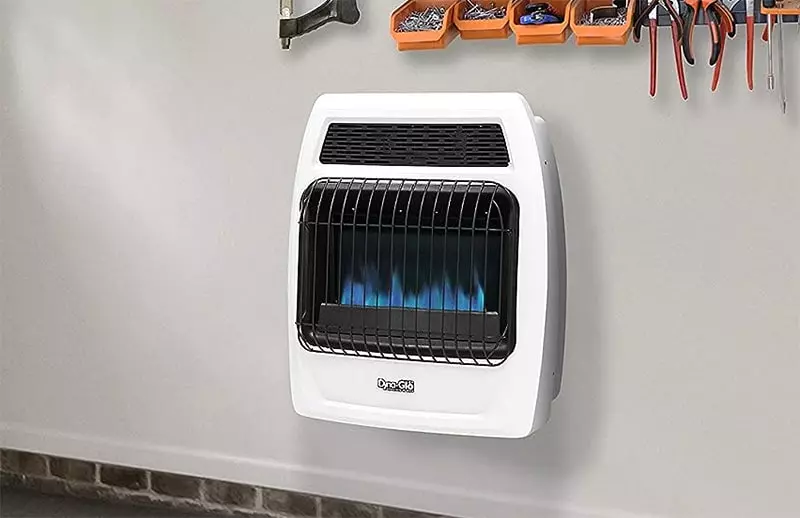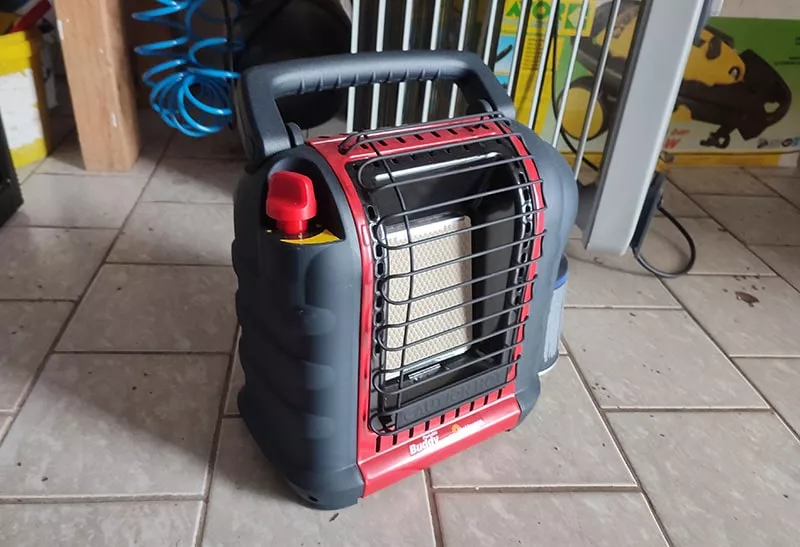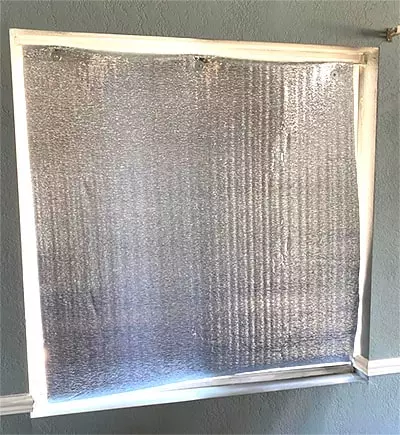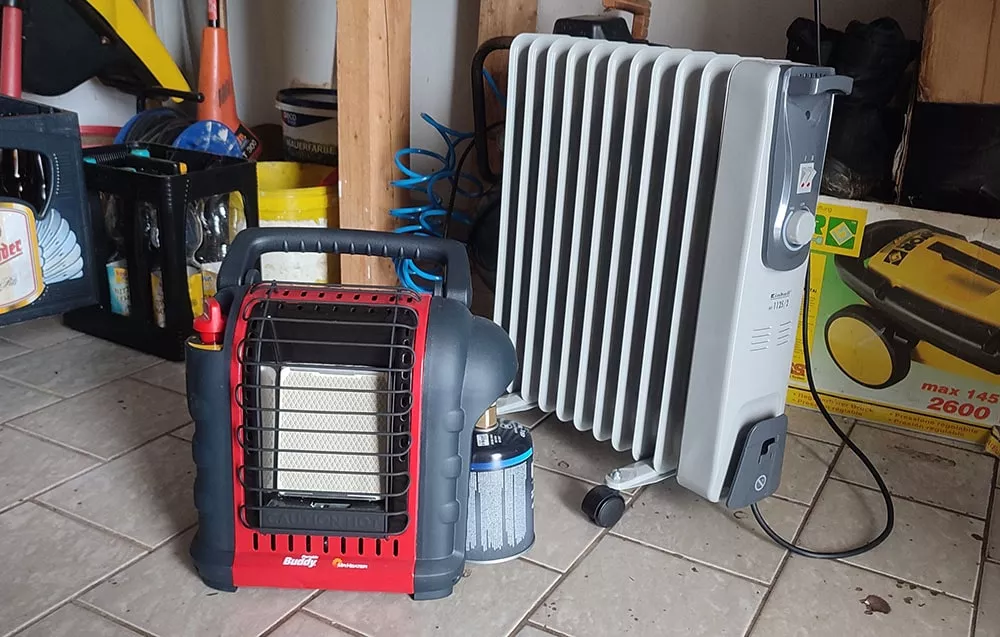What’s the best heater for a shed? Of course, there is not a single right answer.
In this article, we’re going to have a look at 4 different space heaters that will work in your shed.
I’ll also explain in which situation each of the recommended heaters is best for you.
And in the end, we’ll have a quick look at some simple steps to improve your shed’s insulation. Insulation and heating go hand in hand, even in a shed!
As an electric engineer, I am always frustrated about generic and unhelpful advice online. My promise:
After reading this article, you’ll know exactly which heater is best for your shed!
Which Heaters Are Good for Sheds?
Most space heaters are strong enough to heat most sheds. If your shed is not both unusually large (>200 square feet) and uninsulated, you can probably heat your shed well with any space heater.
Regular sheds are usually so compact that heating power is not a concern.
But the source of the heat is.
What the best heater is for your shed depends on the following questions:
- Are you looking for a fixed installed heater or should it be a portable heater?
- Does your shed have access to electricity?
- Is your shed weatherproof?
Here’s the quick answer:
For most sheds, a portable or wall-mounted propane heater is the best choice. They output the most heat for the least cost. Alternatively, you can use a heavy-duty extension cord to power an electric infrared heater or an oil-filled radiator in your shed.
And, of course, the better your shed’s insulation, the better it will heat up.
So, let’s start with the simplest possible heating solution for most sheds, a propane heater:
1. Best Heater for Most Sheds: Dyna-Glo Wall-mounted Propane Heater
Even though this heater might not be suitable for your situation, stick out.
My first recommendation that works with most sheds is this Dyna-Glo wall-mounted propane heater (click to view it on amazon).
I ranked this heater the #1 for most sheds for the following reasons:
- No electricity required: Propane heaters run independently of your home’s electric circuit. It doesn’t require a wall outlet or an extension cord in your shed. All you need is a propane tank.
- Cheap to run: Propane heaters are cheaper to run than electric heaters. In the long run, you’ll save money compared to running an electric space heater.
- Outputs more heat than electric heaters: Propane heaters output much more heat than electric space heaters. In the freezing winter this can make a huge difference.
While a regular electric space heater might keep the shed at mild temperatures, a propane heater will keep it at any temperature all year round. - Emergency heat: In an electric outage you can rely on your propane heater. Since it works without electricity and you can store large 100lb propane tanks in your shed, you can use a propane heater as a backup heater to rely on.
 The Dyna-Glo wall-mounted propane heater is perfect for most sheds!
The Dyna-Glo wall-mounted propane heater is perfect for most sheds!
Personally, I consider all these points to be very strong reasons to get a propane heater for your shed over an electric heater.
But of course, there are downsides.
This particular model, for example, has to be wall-mounted. While that’s great for a permanent installation, it can be impractical if you plan to move your heater around a lot.
And also, you’ll need to get propane refills. Propane tanks last a very long time. But, depending on your usage, you’ll have to get a 100lb refill every month or at least every year.
Overall, I’d say: A wall-mounted propane heater is technically the best shed heater. They output more heat and are cheaper to run than electric heaters. And they don’t take up precious floor space.
But you’ll have to refill the propane.
If that’s not for you, you should get an electric heater.
2. Best Portable Shed Heater: Mr. Heater (Big) Buddy
My all-time favorite propane heater is the Mr. Heater Big Buddy portable propane heater(click to view it on amazon).
Mr. Heater Buddy series heaters come in three different sizes, the
- Little Buddy
- Buddy and
- Big Buddy (the one I linked above)
All of them are great heaters. But for most sheds, I’d say you should pick the Big Buddy.
Personally, I have the Mr. Heater Buddy (the medium-sized heater), and I wish I’d bought the bigger heater instead!
The Mr. Heater Buddy heaters are probably the most popular portable propane heaters in the world. And I’ve been writing about them a lot. They are safe and work in harsh circumstances such as in tents and even at high altitudes.
So:
And since they reliably heat in these conditions, they will definitely work in your shed.
But in which case should you pick such a portable propane heater over a wall-mounted propane heater?
That’s simple:
If you plan to move your heater around a lot, or if you want to heat other spaces such as your garage or a workshop, then you should get a portable propane heater.
You can take them literally anywhere.
And what I like most:
Portable propane heaters don’t necessarily provide less heat than wall-mounted propane heaters.
The Mr. Heater Big Buddy (recommended in this section), for example, outputs 18,000 BTU of heat energy per hour. The wall-mounted heater (recommended earlier) outputs 20,000 BTU per hour. So, the heat output is roughly identical.
Except for the fact that you can’t mount a portable heater to the shed’s wall, there is absolutely no drawback to getting one.
 Here’s my Mr. Heater Buddy propane heater: Totally reliable & works in the freezing cold.
Here’s my Mr. Heater Buddy propane heater: Totally reliable & works in the freezing cold.
3. Best Electric Heaters for Sheds
The heaters we checked so far all require propane gas to run. Of course, you can also use an electric heater for your shed!
All you need is access to electricity.
If you don’t have access to electricity in your shed right now, probably the easiest solution is to get a heavy-duty extension cord for space heaters and connect it to the nearest wall outlet (e.g. at your nearby garage, or the patio).
In general, you can’t miss with this 100 ft. heavy duty extension cord (click to view it on amazon).
Please note that this cord has a length of 100 feet. Usually, this fits most house & shed constellations. But if your shed is either closer or farther away from your house, you can pick a length that better suits you.
Now that the electricity question is settled, let’s pick a heater.
In my opinion, the best electric heater for a shed must be either an infrared heater or an oil-filled radiator.
Infrared heaters are very energy-efficient and provide heat a lot faster than other heaters. After turning my infrared heater on, I can sense heat within a couple of seconds!
Oil-filled radiators on the other hand provide a much more comfortable form of heat since they don’t rely on heat radiation. Instead, they heat the air in your shed.
Also, they are safer. And, since they are usually full-metal devices, they are absolutely weatherproof.
Here are my recommendations:
Infrared Heater For Quick & Efficient Heat
I recommend this Heat Storm infrared heater (click here to view it on amazon).
It heats instantly, and, on top of that, you can mount it to your shed’s wall or to the ceiling.
So, it doesn’t take up any floor space.
Also, since you radiate heat downward from the wall or the ceiling, the heat feels very natural. Just like the sun in summer.
Oil-filled Radiator That Lasts Decades
Oil-filled radiators are very durable. They are especially useful in sheds that already have basic insulation since they heat the entire space inside your shed.
The better insulated your shed is, the better an oil-filled radiator works.
My grandpa used an oil oil-filled radiator in his workshop for decades. Since these types of heaters don’t have any parts that get excessively hot and they don’t contain any moving parts that wear down over time, oil-filled radiators are practically indestructible.
I recommend getting this De’Longhi oil-filled radiator(click here to view it on amazon).
It will last. Guaranteed.

Quick Recap: When to pick which heater
Here’s your guideline in which case you should pick which shed heater:
- Wall-mounted propane heater: Best for sheds where a permanent heating solution is desired. Doesn’t require electricity and outputs more heat than electric heaters. Requires periodic propane refills.
This is the best heating option for most sheds. - Portable propane heater: Best for those who need a portable heating solution that can be used in multiple spaces. Similar heating efficiency to a wall-mounted propane heater.
Pick this heater if you plan to use the heater in different spaces. - Electric infrared heater: Your choice if you have access to electricity and want fast, efficient heat. Can be wall-mounted to save floor space.
Pick this heater if you don’t want to worry about propane gas refills. - Oil-filled Radiator: Another electric option that’s durable and provides comfortable heat over a longer period. Best for insulated sheds.
Pick this heater if you don’t want to worry about propane gas refills and you want your heater to be weatherproof!
How to Insulate Your Shed for Better Heating
No matter how powerful your heater is, a poorly insulated shed will always feel cold and will also burn through fuel or electricity at a much higher rate.
In the freezing wintertime, insulation makes the difference between being able to keep the temperature above freezing and actually reaching comfortable levels.
You know your shed much better than I do. And I don’t want to preach about insulation too much.
But let’s have a look at a couple of simple shed insulation tips that can make a large difference:
Reflective Insulation
Probably the simplest way to really make a large insulation difference in your shed is to add a layer of reflective insulation to the walls.
I recommend this SmartSHIELD insulation roll (click here to view it on amazon).
This type of insulation reflects heat back towards its source, making it useful for both retaining heat in the winter and reflecting heat away in the summer.
Installing a radiant barrier is usually as simple as stapling the material to your shed’s walls or roof.
You can also cover your shed’s windows with it.
 Reflective insulation wraps make a large difference! You can even cover your shed window with a layer of reflective insulation.
Reflective insulation wraps make a large difference! You can even cover your shed window with a layer of reflective insulation.
Under-Door Air Draft Stoppers & Door Sweeps
One of the most overlooked aspects of insulation is the gap beneath the door. This small space can let in a surprising amount of cold air, undermining your heating efforts.
Installing an under-door air draft stopper takes no more than half an hour, and the difference is immediately noticeable.
I recommend this all-season door sweep(click to view it on amazon).
Weather Stripping
You can also install some simple weather stripping around doors and windows to prevent drafts and heat loss. It is one of the cheapest yet most effective ways to improve your shed’s insulation.
I recommend this Duck Brand weatherstripping seal(click here to view it on amazon). It’s a simple stick-on solution that can go a long way in keeping your shed warm
Seal Gaps and Cracks
If you’re not ready for a big insulation project, even small efforts can make a difference. For instance, sealing gaps and cracks around windows and doors with caulk can prevent drafts. Weatherstripping is another simple option for doors and windows.
By combining these various forms of insulation, you’ll create a shed that’s not just warm, but also energy-efficient.
In the long run, proper insulation will pay for itself by reducing the amount of fuel or electricity needed to keep your shed comfortable.
An uninsulated shed just won’t heat well in the freezing wintertime.
Conclusion
If I had to pick a heater for my shed today, I’d always get a propane heater. They output much more heat. And I just like the feeling propane heaters provide.
The propane flame and the glowing red hot heating panel just make a cozy shed.
Electric heaters are, of course, also possible if your shed has access to electricity. But these always have lower heat output and electric heaters are more expensive to run than propane heaters.
Insulation is the key counterpart to effective heating. Simple steps like adding reflective insulation and weather stripping will make heating more effective and efficient, regardless of which heater you choose.
